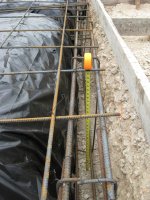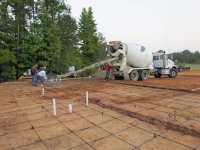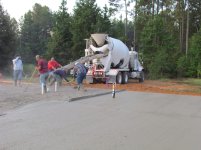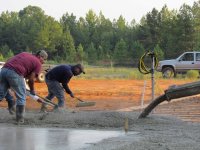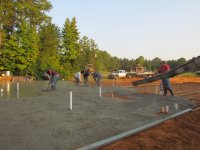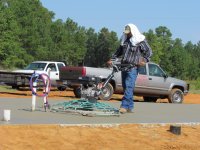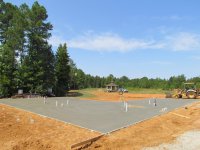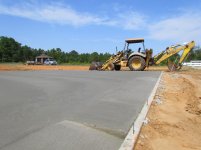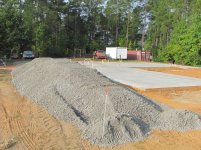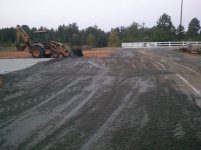EddieWalker
Epic Contributor
Vapor Barrier under a concrete slab on a single story house is a misnamer. It's purpose is to control the moisture in the concrete when pouring on certain soils that will dry out the concrete when it's still wet. I have very good red clay that I will dampen before the concrete is poured and not have any need for plastic under the slab.
Radon isn't a concern on a single story slab that is on grade.
Humidity or moisture on top of a concrete slab has nothing to do with there being plastic under the slab or not. It is 100 percent the result of water content in the air and the different temperature of the concrete to the air around it. Warmer air and cooler concrete will lower the ability of the air to hold moisture, resulting in moisture on the slab. Insulation under the concrete might help this, or heating the air above the concrete to where it can hold more moisture and not creat condensation. Air movement, such as fans or proper venting will dry out the condensation before you see it in some cases, and keep it to a minimum in other cases.
And for those who want to share their belief that water will come up from the ground and go through my concrete to bring moisture into the house, I disagree. In every house there are drain lines and there are traps. Where the traps are located, the surrounding concrete doesn't touch the trap, leaving exposed dirt under your tub and shower. This soil is extremly dry and hard. I do this for a living and if I find any moisture there, it's because there was a leak.
Water will always take the path of least resistance. Going up and then through 3 1/2 inches of concrete isn't going to happen. If you don't believe me, put a 3 1/2 inch thich piece of concrete in to a puddle of water that is an inch or so deep and wait. Plan on being there a very long time, because water will NEVER work it's way up to the surface of that piec of concrete sitting in water.
And on those jobs where I have been where they do put down plastic, it's more of a joke then actually trying to keep water from getting from the ground to the concrete. I've never seen it taped, or sealed in any way. I've never seen it done in a single piece. It's cut and torn all over the place by the time it's ready to pour. It's one of those things that was done to keep the concrete moist all the way through, and nothing to do with water coming up from the ground and into a house.
Thank you,
Eddie
Radon isn't a concern on a single story slab that is on grade.
Humidity or moisture on top of a concrete slab has nothing to do with there being plastic under the slab or not. It is 100 percent the result of water content in the air and the different temperature of the concrete to the air around it. Warmer air and cooler concrete will lower the ability of the air to hold moisture, resulting in moisture on the slab. Insulation under the concrete might help this, or heating the air above the concrete to where it can hold more moisture and not creat condensation. Air movement, such as fans or proper venting will dry out the condensation before you see it in some cases, and keep it to a minimum in other cases.
And for those who want to share their belief that water will come up from the ground and go through my concrete to bring moisture into the house, I disagree. In every house there are drain lines and there are traps. Where the traps are located, the surrounding concrete doesn't touch the trap, leaving exposed dirt under your tub and shower. This soil is extremly dry and hard. I do this for a living and if I find any moisture there, it's because there was a leak.
Water will always take the path of least resistance. Going up and then through 3 1/2 inches of concrete isn't going to happen. If you don't believe me, put a 3 1/2 inch thich piece of concrete in to a puddle of water that is an inch or so deep and wait. Plan on being there a very long time, because water will NEVER work it's way up to the surface of that piec of concrete sitting in water.
And on those jobs where I have been where they do put down plastic, it's more of a joke then actually trying to keep water from getting from the ground to the concrete. I've never seen it taped, or sealed in any way. I've never seen it done in a single piece. It's cut and torn all over the place by the time it's ready to pour. It's one of those things that was done to keep the concrete moist all the way through, and nothing to do with water coming up from the ground and into a house.
Thank you,
Eddie
